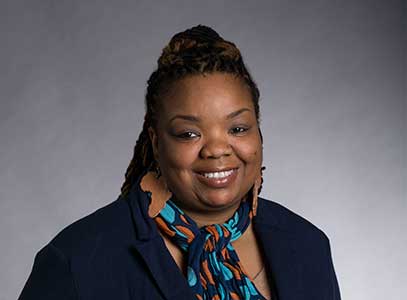Wellesley Centers for Women Welcomes Two New Research Scientists
The work of Research Scientist LaShawnda Lindsay focuses on factors influencing the academic experiences of African American girls and young women—including the teaching and the curricula presented to them and the culture, aspirations, and expectations they bring to their classrooms.

Why have you chosen to come to the Wellesley Centers for Women (WCW)?
I became familiar with the Centers, particularly the Stone Center, between 2001 and 2003, when I was a master’s student, during the period when my work really started to take form. Initially my research was in the academic underperformance of African American adolescents in general, but as I searched the literature I would always see a focus on males—boys, boys, Black boys, Black boys, and I began to wonder, OK, what’s going on with Black girls? After all, I am a Black girl, and there were some significant things about my experience that ought to be explored. As I started to consider the role of gender, I discovered a lot of the work that came out of the Wellesley Centers for Women. And now that I actually am professionally based at the place that first helped me to investigate and learn about girls’ experiences, I feel that this is a full-circle moment.
Do you hope to be doing more work with the National Science Foundation (NSF)?
Yes. Right now I’m closing out a three-year grant from NSF, but I have a background in culturally responsive mentoring, and I’ve developed an idea that integrates principles or theories from culturally responsive teaching with informal STEM learning environments for Black girls. I’m actually looking to apply this approach particularly to projects involving DIY or Maker work, because that’s what I myself do for pleasure.
“Maker” work?
Yes. I make my own jewelry, and I sell it; I do the designing and graphics for the jewelry. And as I got into it recently, I realized how the tasks I’m doing relate to engineering and technology. And I see how I can use that as a way to get girls interested in computer science and technology and introduce them to digital fabrication, giving them transferable skills and the kinds of design modeling that engineers use. Most girls of color don’t think it’s appropriate or useful for them to master STEM fields; this is a way to help their STEM learning become more interesting and efficacious.
Can you give us a DIY example?
A lot of my personal DIY activity has been in fashion. Right now I’m working on creating a line of clutch bags with African graphics. So when I sit down to design a clutch bag, I need to figure out how much material I’ll need, deciding how much internal space I need to allow for, so a woman can put things into the bag—after all, I’m not designing an envelope! And I realize that “Oh! This is geometry! If my school geometry teacher had used this example in class, I would have been interested and remembered it, and might not be struggling this way right now.”
Certainly a sewing machine is part of the work of making a clutch bag. Can this kind of work involve a number of challenges and a variety of machines?
Certainly. For a variety of DIY tasks you could need a drill press, various dremel tools, a scroll saw, a CO2 laser engraver if you’re using your own design, a CNC (Computer Numeric Control) machine if you want to cut your design with a metal tip rather than a laser, a computer program like Adobe Illustrator or Ink Space to adjust the design after you’ve created it, and so on. Actually some of these tools are oversized for many DIY projects. I’d love to see one of our young women go off to college and become an engineer and design a small drill press or a more affordable CO2 laser engraver.
So would this kind of project be part of a high school course?
Middle school, high school, or college. One great thing about coming to Wellesley is that in the Boston area there’s a large “maker community.” For example, a professor at MIT created a concept called “Fab Lab,” where lay persons can come in and learn how to use 3-D printers and other machinery that they would need in order to make the things they want. And since I’ve been at Wellesley, I’ve learned that there is a Maker community at the college. I’d like to work with the resources and students that are there to create a program for public schools to help girls learn how to use some of this machinery and to become more interested in it.
And Wellesley students would help develop the program?
Yes. They could be like the mentors to the program.
Are there related programs that you’ve seen?
The South End Technology Center in Boston has a summer “Fab Lab” program that trains high school youth to teach digital fabrication to younger students and elementary students, while they themselves become more fluent in it. At the end of the summer, the high school students actually produce something that solves an issue in the community. I saw some of their projects last August. One involved helping elderly people keep their keys and other precious items safe. It uses a lockbox that opens in response to a certain thumbprint as opposed to a key. My program will focus on cultural artifacts as fashion. For example, a cultural artifact might be a particular representation of African culture, used in jewelry.
Would you summarize more broadly for us what strengths you bring to WCW, what expertise?
I’ve done a lot of work developing youth-mentoring programs—primarily for girls—that try to draw on the natural and cultural strengths of the population that I’m working with. I’ve also done research looking at family, racial, and ethnic socialization to see how messages that parents transmit to their children— particularly African American children—teach them to navigate through the wider society.
Does something stand out in your experience as especially exciting?
Research is great, but when I’m actually in front of young women and girls—that’s when I feel most happy and the most aware of the impact of my work. It’s one thing to sit back and write articles; but sometimes you can become so theoretical that you are far removed from the population that you’re studying. So those moments when I can sit down with young girls and young women—that makes me smile and keeps me pressing to do this kind of work.


